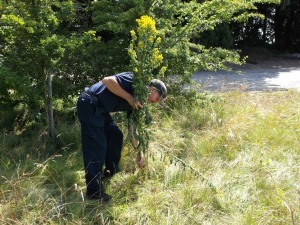Ragwort
There is some debate over whether ragwort, Senecio jacobaea, is a weed that requires removal by landowners. It is named as one of five ‘injurious’ weeds covered by the Weeds Act of 1959. The label ‘injurious’ is misleading for humans though, as it is only poisonous for cattle and horses etc, that ingest large quantities of the weed. Many believe that, like other ‘weeds’, they can have a positive effect on biodiversity.
The Weeds Act 1959 does not actually require landowners to remove the weed, but states,”Where the Minister of Agriculture, Fisheries and Food is satisfied that there are injurious weeds… growing upon any land he may serve upon the occupier of the land a notice in writing requiring him… to take such action as may be necessary to prevent the weeds from spreading.”
So, why do greenkeepers remove ragwort from the playing area?
Firstly, ragwort can grow very large, and many individual plants are found in clumps. This could make finding balls and, by extension, playability more difficult than necessary. Secondly, if the landowners wished to bale long rough at the end of the growing season for fodder, farmers would not wish to find potentially poisonous plants in the mix. Lastly, ragwort is very invasive, and can ‘take hold’ of large areas very quickly.
At North Foreland ragwort is removed by hand on a regular basis to keep the weed’s numbers under control. While there are potential benefits to having ragwort on site, removal to a point of control is the objective.


